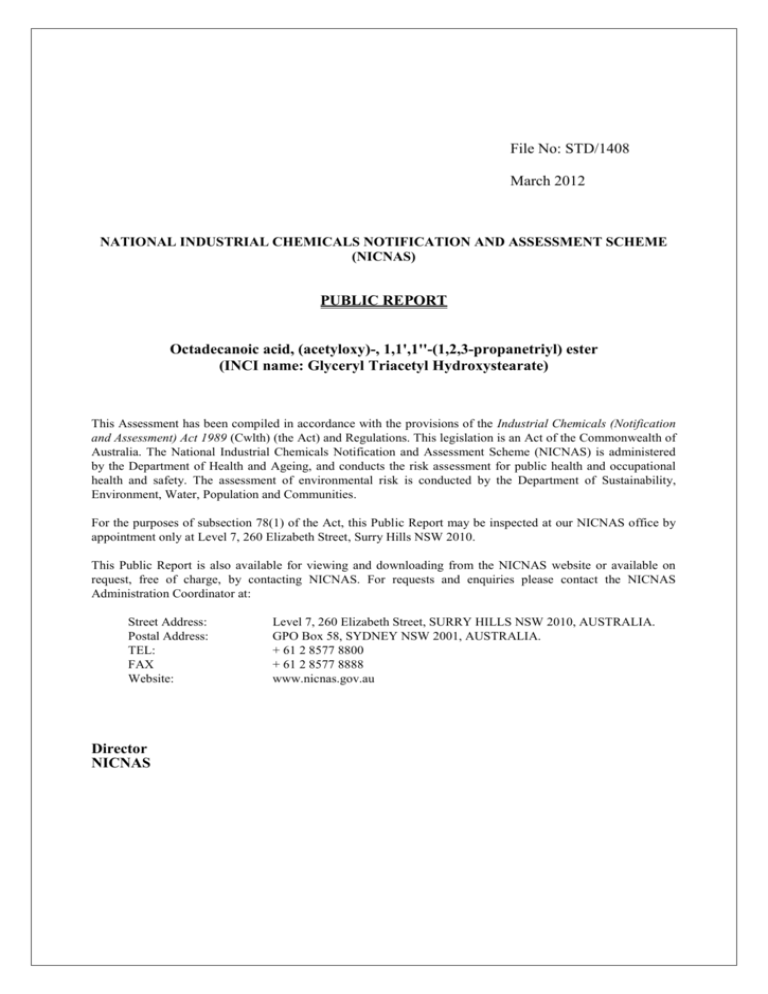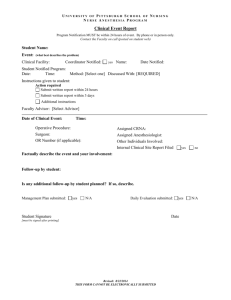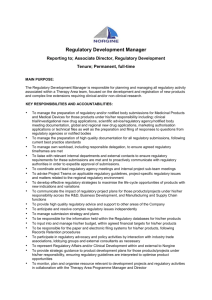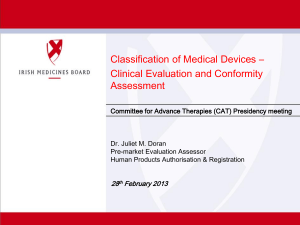STD/1408
advertisement

File No: STD/1408 March 2012 NATIONAL INDUSTRIAL CHEMICALS NOTIFICATION AND ASSESSMENT SCHEME (NICNAS) PUBLIC REPORT Octadecanoic acid, (acetyloxy)-, 1,1',1''-(1,2,3-propanetriyl) ester (INCI name: Glyceryl Triacetyl Hydroxystearate) This Assessment has been compiled in accordance with the provisions of the Industrial Chemicals (Notification and Assessment) Act 1989 (Cwlth) (the Act) and Regulations. This legislation is an Act of the Commonwealth of Australia. The National Industrial Chemicals Notification and Assessment Scheme (NICNAS) is administered by the Department of Health and Ageing, and conducts the risk assessment for public health and occupational health and safety. The assessment of environmental risk is conducted by the Department of Sustainability, Environment, Water, Population and Communities. For the purposes of subsection 78(1) of the Act, this Public Report may be inspected at our NICNAS office by appointment only at Level 7, 260 Elizabeth Street, Surry Hills NSW 2010. This Public Report is also available for viewing and downloading from the NICNAS website or available on request, free of charge, by contacting NICNAS. For requests and enquiries please contact the NICNAS Administration Coordinator at: Street Address: Postal Address: TEL: FAX Website: Director NICNAS Level 7, 260 Elizabeth Street, SURRY HILLS NSW 2010, AUSTRALIA. GPO Box 58, SYDNEY NSW 2001, AUSTRALIA. + 61 2 8577 8800 + 61 2 8577 8888 www.nicnas.gov.au TABLE OF CONTENTS SUMMARY ............................................................................................................................................................ 3 CONCLUSIONS AND REGULATORY OBLIGATIONS ................................................................................... 3 ASSESSMENT DETAILS ..................................................................................................................................... 4 1. APPLICANT AND NOTIFICATION DETAILS .................................................................................... 4 2. IDENTITY OF CHEMICAL .................................................................................................................... 5 3. COMPOSITION ....................................................................................................................................... 5 4. PHYSICAL AND CHEMICAL PROPERTIES ....................................................................................... 5 5. INTRODUCTION AND USE INFORMATION ..................................................................................... 6 6. HUMAN HEALTH IMPLICATIONS ..................................................................................................... 7 6.1. Exposure Assessment ...................................................................................................................... 7 6.1.1. Occupational Exposure ............................................................................................................... 7 6.1.2. Public Exposure .......................................................................................................................... 7 6.2. Human Health Effects Assessment ................................................................................................. 8 6.3. Human Health Risk Characterisation ............................................................................................ 10 6.3.1. Occupational Health and Safety ............................................................................................... 10 6.3.2. Public Health ............................................................................................................................ 10 7. ENVIRONMENTAL IMPLICATIONS ................................................................................................. 10 7.1. Environmental Exposure & Fate Assessment ............................................................................... 10 7.1.1. Environmental Exposure .......................................................................................................... 10 7.1.2. Environmental Fate .................................................................................................................. 11 7.1.3. Predicted Environmental Concentration (PEC) ........................................................................ 11 7.2. Environmental Effects Assessment ............................................................................................... 12 7.2.1. Predicted No-Effect Concentration .......................................................................................... 12 7.3. Environmental Risk Assessment ................................................................................................... 12 APPENDIX A: TOXICOLOGICAL INVESTIGATIONS ................................................................................................... 13 B.1. Acute toxicity – oral ...................................................................................................................... 13 B.2. Irritation – skin .............................................................................................................................. 13 B.3. Irritation – eye ............................................................................................................................... 13 B.4. Skin sensitisation – human volunteers .......................................................................................... 14 APPENDIX B: ENVIRONMENTAL FATE AND ECOTOXICOLOGICAL INVESTIGATIONS ............................................... 15 C.1. Ecotoxicological Investigations .................................................................................................... 15 C.2.1. Acute toxicity to aquatic invertebrates ................................................................................ 15 BIBLIOGRAPHY ................................................................................................................................................. 16 March 2012 NICNAS SUMMARY The following details will be published in the NICNAS Chemical Gazette: ASSESSMENT APPLICANT(S) REFERENCE STD/1408 Avon Products Pty Ltd CHEMICAL OR HAZARDOUS INTRODUCTION TRADE NAME SUBSTANCE VOLUME Octadecanoic acid, (acetyloxy)-, 1,1',1''(1,2,3-propanetriyl) ester (INCI name: Glyceryl Triacetyl Hydroxystearate) ND* ≤2 tonnes per annum USE Component of rinse-off and leave-on cosmetic products *ND = not determined CONCLUSIONS AND REGULATORY OBLIGATIONS Hazard classification Based on the limited data available the notified chemical cannot be classified according to the Approved Criteria for Classifying Hazardous Substances (NOHSC, 2004) or the Globally Harmonised System for the Classification and Labelling of Chemicals (GHS) (United Nations 2009). Human health risk assessment Under the conditions of the occupational settings described, the notified chemical is not considered to pose an unreasonable risk to the health of workers. When used in the proposed manner, the notified chemical is not considered to pose an unreasonable risk to public health. Environmental risk assessment On the basis of the limited aquatic exposure, expected low hazard and assessed use pattern, the notified chemical is not expected to pose an unreasonable risk to the environment. Recommendations CONTROL MEASURES Occupational Health and Safety Employers should implement the following isolation and engineering controls to minimise occupational exposure to the notified chemical during reformulation processes: Enclosed, automated processes, where possible Employers should implement the following safe work practices to minimise occupational exposure during handling of the notified chemical during reformulation processes: Avoid contact with skin Employers should ensure that the following personal protective equipment is used by workers to minimise occupational exposure to the notified chemical during reformulation processes: Coveralls, impervious gloves Guidance in selection of personal protective equipment can be obtained from Australian, Australian/New Zealand or other approved standards. A copy of the MSDS should be easily accessible to employees. If products and mixtures containing the notified chemical are classified as hazardous to health in accordance with the Approved Criteria for Classifying Hazardous Substances [NOHSC:1008(2004)] PUBLIC REPORT: STD/1408 Page 3 of 17 March 2012 NICNAS workplace practices and control procedures consistent with provisions of State and Territory hazardous substances legislation must be in operation. Disposal The notified chemical should be disposed of to landfill. Regulatory Obligations Secondary Notification This risk assessment is based on the information available at the time of notification. The Director may call for the reassessment of the chemical under secondary notification provisions based on changes in certain circumstances. Under Section 64 of the Industrial Chemicals (Notification and Assessment) Act (1989) the notifier, as well as any other importer or manufacturer of the notified chemical, have post-assessment regulatory obligations to notify NICNAS when any of these circumstances change. These obligations apply even when the notified chemical is listed on the Australian Inventory of Chemical Substances (AICS). Therefore, the Director of NICNAS must be notified in writing within 28 days by the notifier, other importer or manufacturer: (1) Under Section 64(1) of the Act; if the concentration of the chemical exceeds or is intended to exceed 9% in cosmetic products or (2) Under Section 64(2) of the Act; if the function or use of the chemical has changed from a component of rinse-off or leave-on cosmetic products, or is likely to change significantly; the amount of chemical being introduced has increased from 2 tonnes per annum, or is likely to increase, significantly; the chemical has begun to be manufactured in Australia; additional information has become available to the person as to an adverse effect of the chemical on occupational health and safety, public health, or the environment. The Director will then decide whether a reassessment (i.e. a secondary notification and assessment) is required. Material Safety Data Sheet The MSDS of the notified chemical provided by the notifier was reviewed by NICNAS. The accuracy of the information on the MSDS remains the responsibility of the applicant. ASSESSMENT DETAILS 1. APPLICANT AND NOTIFICATION DETAILS APPLICANT(S) Avon Products Pty Ltd (ABN 48 008 428 457) 120 Old Pittwater Road Brookvale NSW 2100 NOTIFICATION CATEGORY Standard: Chemical other than polymer (more than 1 tonne per year). EXEMPT INFORMATION (SECTION 75 OF THE ACT) No details are claimed exempt from publication. VARIATION OF DATA REQUIREMENTS (SECTION 24 OF THE ACT) Variation to the schedule of data requirements is claimed as follows: all physico-chemical properties, all toxicological (except acute oral toxicity and skin and eye irritation) and all ecotoxicological endpoints (except toxicity to daphnia). PREVIOUS NOTIFICATION IN AUSTRALIA BY APPLICANT(S) PUBLIC REPORT: STD/1408 Page 4 of 17 March 2012 NICNAS None NOTIFICATION IN OTHER COUNTRIES None 2. IDENTITY OF CHEMICAL MARKETING NAME(S) Glyceryl Triacetyl Hydroxystearate Hetester HCA CAS NUMBER 27233-00-7 CHEMICAL NAME Octadecanoic acid, (acetyloxy)-, 1,1',1''-(1,2,3-propanetriyl) ester OTHER NAME(S) Glyceryl Triacetyl Hydroxystearate (INCI name) MOLECULAR FORMULA C63H116O12 STRUCTURAL FORMULA R is derived from (acetyloxy)octadecanoic acid MOLECULAR WEIGHT Mn 1065 Da ANALYTICAL DATA Reference IR spectrum was provided. 3. COMPOSITION DEGREE OF PURITY ≥99.5% HAZARDOUS IMPURITIES/RESIDUAL MONOMERS None NON HAZARDOUS IMPURITIES/RESIDUAL MONOMERS (>1% by weight) ADDITIVES/ADJUVANTS 4. None None PHYSICAL AND CHEMICAL PROPERTIES APPEARANCE AT 20 ºC AND 101.3 kPa: Hazy yellow viscous liquid. Property Melting Point/Freezing Point PUBLIC REPORT: STD/1408 Value ~15 ºC Data Source/Justification MSDS Page 5 of 17 March 2012 NICNAS Density Vapour Pressure 960 kg/m3 at 25 °C Not determined Water Solubility Not determined Hydrolysis as a Function of pH Not determined Partition Coefficient (n-octanol/water) Not determined Adsorption/Desorption Not determined Dissociation Constant Not determined Flash Point Autoignition Temperature >200 °C >200 °C (based on flash point) Explosive Properties Not determined Oxidising Properties Not determined MSDS Expected to be low based on the high molecular weight. Expected to have low water solubility based on its predominantly hydrophobic structure Contains hydrolysable functionality, however, due to its low predicted water solubility, it is expected to hydrolyse slowly in the environmental pH range (4-9). Considered stable at pH 4-6 based on recommended conditions of use. Expected to partition from water to noctanol on the basis of its low predicted water solubility and predominantly hydrophobic structure Expected to adsorb to soil, sediment and sludge due to its expected low water solubility and high molecular weight Does not contain dissociable functionality MSDS Not expected to autoignite under normal conditions Contains no functional groups that imply explosive properties Contains no functional groups that imply oxidative properties DISCUSSION OF PROPERTIES Reactivity Expected to be stable under normal conditions. The MSDS states that the notified chemical should be kept away from alkalis, oxidising agents and corrosive substances. Dangerous Goods classification Based on the limited submitted physical-chemical data in the above table the notified chemical is not classified according to the Australian Dangerous Goods Code (NTC, 2007). However, the data above do not address all Dangerous Goods endpoints. Therefore, consideration of all endpoints should be undertaken before a final decision on the Dangerous Goods classification is made by the introducer of the chemical. 5. INTRODUCTION AND USE INFORMATION MODE OF INTRODUCTION OF NOTIFIED CHEMICAL (100%) OVER NEXT 5 YEARS The notified chemical will be imported at 100% concentration and as a component of finished cosmetic products at up to 9% concentration. MAXIMUM INTRODUCTION VOLUME OF NOTIFIED CHEMICAL (100%) OVER NEXT 5 YEARS Year Tonnes 1 2 2 2 3 2 4 2 5 2 PORT OF ENTRY Sydney, by wharf. IDENTITY OF MANUFACTURER/RECIPIENTS Avon Products Pty Ltd. TRANSPORTATION AND PACKAGING PUBLIC REPORT: STD/1408 Page 6 of 17 March 2012 NICNAS The notified chemical (at 100% concentration) will be imported in ~200 kg containers or as a component of formulated cosmetic products in containers suitable for retail sale. The containers will be packaged in cardboard cartons and will be distributed within Australia by road. USE The notified chemical will be used as a skin conditioning agent in a variety of rinse-off and leave-on cosmetic products at up to 9% concentration. OPERATION DESCRIPTION The notified chemical (at 100% concentration) will be used in the formulation of cosmetics. The process will vary depending on the nature of the product and may involve both automated and manual transfer steps. A typical formulation process will likely involve manual weighing of the notified chemical into a mixing tank (closed system) and then automated packaging of the formulated product into containers for retail sale. Reformulation processes are expected to occur under exhaust ventilation. The final consumer products (containing the notified chemical at up to 9% concentration) will be distributed to retail outlets, displayed and sold to consumers and professionals such as hair dressers and beauty salon workers. Depending on the nature of the end-use product, these could be applied in a number of ways, such as by hand, using an applicator or by spray. 6. HUMAN HEALTH IMPLICATIONS 6.1. 6.1.1. Exposure Assessment Occupational Exposure CATEGORY OF WORKERS Category of Worker Transport and storage Professional compounder Chemist Packers Store persons Salon workers Exposure Duration (hours/day) 4 8 3 8 4 unspecified Exposure Frequency (days/year) 12 12 12 12 12 unspecified EXPOSURE DETAILS Transportation and storage workers will only be exposed to the notified chemical (at 100% concentration) or to end-use products (at up to 9% concentration) in the unlikely event of an accident. During cosmetic formulation processes, including quality control, transfer, and cleaning and maintenance tasks, dermal and ocular exposure may occur. Exposure is expected to be minimised by the use of ventilation and the use of personal protective equipment (PPE), including goggles, impervious gloves and appropriate industrial clothing. Due to the estimated low vapour pressure of the notified chemical, inhalation exposure is not expected. Exposure of workers to the notified chemical in end-use products may occur in professions where the services provided involve the application of cosmetic and personal care products to clients (e.g., workers in beauty salons). Such professionals may use PPE to minimise repeated exposure, and good hygiene practices are expected to be in place. If PPE are used, exposure to such workers is expected to be of a similar or lesser extent than that of consumers. 6.1.2. Public Exposure There will be widespread and repeated exposure of the public to the notified chemical (at up to 9% concentration) through the use of rinse-off and leave-on cosmetic and personal care products. The main routes of exposure will be dermal and oral (through the use of lip products), although ocular and inhalation exposure may also occur. PUBLIC REPORT: STD/1408 Page 7 of 17 March 2012 6.2. NICNAS Human Health Effects Assessment The results from toxicological investigations conducted on the notified chemical are summarised in the table below. Details of these studies can be found in Appendix A. Endpoint Rat, acute oral toxicity* Rabbit, skin irritation* Rabbit, eye irritation* Human repeat insult patch test (HRIPT) *Study summary only provided Result and Assessment Conclusion LD50>5000 mg/kg bw; low toxicity slightly irritating slightly irritating no evidence of sensitisation While only limited studies have been conducted on the notified chemical (as summarised in the above table), extensive information has been published on the toxicity that is associated with triglycerides, glycerol and free fatty acids (see for example: CIR, 1999; CIR, 2000; CIR, 2001; CIR, 2007; OECD, 2002; HERA, 2002). Some of this information is discussed below. Toxicokinetics, metabolism and distribution. Given the high molecular weight (1065 Da), expected low water solubility and high partition coefficient of the notified chemical, dermal absorption is expected to be limited. Following oral administration, it is expected that the notified chemical will be metabolised in the small intestine to the monoglyceride, glycerol and free fatty acid, which will then be systemically absorbed, similar to other triglycerides, with the rate of metabolism having been shown to vary with fatty acid chain length (CIR, 2001). The rate of metabolism of the notified chemical, relative to other triglycerides, may also be affected by the presence of the acetyloxy (and/or hydroxyl) moieties. Acute toxicity. The notified chemical was determined to have low acute oral toxicity in rats (LD50>5000 mg/kg bw). While the full study report was not provided, this result is consistent with those reported for other triglycerides, which are derived from C8-22 fatty acids (CIR, 2001). Acute dermal toxicity data was not provided on the notified chemical. However, as indicated above, the potential for absorption (and hence systemic toxicity) via the dermal route is expected to be limited. Irritation and Sensitisation. The notified chemical was determined to be slightly irritating to the skin and eyes of rabbits, with the reported levels of irritation not warranting classification of the chemical as a skin or eye irritant. While the full study reports were not provided, the reported extent of irritation is consistent with study results reported for other triglycerides, which are derived from C8-22 fatty acids (CIR, 2001). Skin sensitisation data obtained from studies conducted on the notified chemical in animals was not provided. However, the notified chemical (at 100% concentration) was not a skin sensitiser in a human repeat insult patch test. Based on the absence of structural alerts in the notified chemical (and expected limited dermal absorption), skin sensitisation is not expected. This is further supported by the absence of skin reactions in animal studies conducted on similar triglycerides (CIR, 2001). Repeated Dose Toxicity. No repeated dose toxicity data is available on the notified chemical. However, information is available on other triglycerides and on potential metabolites of the notified chemical, for example: In a series of studies on the triglyceride, tricaprylin (C8), the short-term, chronic and developmental toxicities were evaluated (Ohta et al., 1970). While detailed protocols in English were not available, brief study summaries were obtained from a CIR report (CIR, 2001). In a 31-day study, rats (7-10/group/sex) were orally administered tricaprylin at 0, 2, 5 or 10 mL/kg bw/day. Statistically significant decreases in organ weights (including the heart, spleen, kidneys and/or testis) were noted in males at all treatment levels, however, there were no lesions noted upon microscopic examination. Changes in the clinical chemistry and haematology parameters were also reported. In a similar 26 week-study in male rats (8-12/group), increases in liver and adrenal gland weights were noted, while in another chronic study microscopic lesions in the kidneys, myocardium and aorta were noted. In a developmental study, mice were orally administered tricaprylin during gestation at 0, 2 or 10 mL/kg bw/day. Of PUBLIC REPORT: STD/1408 Page 8 of 17 March 2012 NICNAS the live foetuses, malformations were noted in 6/220 from the 2 ml/kg bw treatment group and 8/219 from the 10 ml/kg bw group (3/220 in the control group). The study authors concluded that tricaprylin was not teratogenic. In a 24 week repeated dose oral toxicity study, 18 rats were administered a diet containing glyceryl trierucate as (C22 unsaturated) 30% of caloric intake, to evaluate heart and kidney pathology. After 1 week, 6/18 animals were sacrificed, with cardiac lipidosis noted in these animals. The extent of cardiac lipidosis in these animals was reportedly more severe than in the remaining 12 animals, which were killed after 24 weeks, and for which cellular/fibrotic scars were noted as the main pathological feature. With respect to the kidneys, tubular dilation, proteinaceous casts or interstitial foci of fibrosis were noted in rats that were killed after 24 weeks (Abdellatif and Vles, 1973). In a 90 day repeated dose oral toxicity study, rats (3 females/group) were fed hydrogenated castor oil (which was reported to contain 86.5% of a potential metabolite of the notified chemical, 12-hydroxystearic acid) at 0, 5, 10 or 20%, administered as granular powder (Binder et al. 1970). Reduced growth rate was observed at 10 and 20%. However, this was postulated to be due to poor digestion of the test substance, as in an additional 90 day feeding study of hydrogenated castor oil (at 0, 1, 5 or 10%) in corn oil, there was no effect on growth rate at any concentration. In either of these studies, no effects on organ weights, haematology or microscopic pathology were noted. These studies were followed by a 16-week study, in which rats were administered hydrogenated corn oil at 0, 1 or 10% in corn oil. At 8 weeks, half of the 1 and 10% groups were fed the control diet (20% corn oil) until completion of the study. Groups were sacrificed at 4, 8, 12 and 16 weeks. There were statistically significant decreases in the body weights in the 10% groups that were fed hydrogenated castor oil for 8 and 16 weeks relative to the control group. However, no other adverse effects were noted. These studies demonstrate weight gain differences between the treatment and control groups that were reported by the study authors to be likely due to differences in caloric intake, as opposed to treatment related toxicity. In a 91 day repeated dose oral toxicity study, rats (25/sex/group) were administered caprenin (triglyceride of caprylic (C8), capric (C10) and behenic (C22) acids) at 5.23, 10.23 or 15% via the diet (HERA, 2002). No adverse effects were noted and the NOAEL was determined to be >15% in the diet (>13.2 g/kg bw/day for male rats and >14.6 g/kg bw/day for female rats). Mutagenicity and carcinogenicity. No genotoxicity data is available on the notified chemical. Mixed results (positive and negative) have been obtained from genotoxicity studies conducted on triglycerides and fatty acids (CIR, 2001; CIR, 2000; CIR, 1999; HERA, 2002). For example, tricaprylin (C8) was noted to be mutagenic in Salmonella typhimurium strain TA1535 with metabolic activation, but did not induce mutations in strain TA1535 without activation, or in strains TA97, TA98, or TA100, with or without metabolic activation (NTP, 1994). Whereas the fatty acid, 9,10dihydroxystearic acid was considered to be non-genotoxic based on a series of studies, including an in vivo micronucleus assay (EFSA, 2006). Triglycerides have been used as controls and vehicles in carcinogenicity studies (CIR, 2001; HERA, 2002), which implies a low level of concern for carcinogenicity. However, the carcinogenic potential of tricaprylin (C8) has been demonstrated (NTP, 1994). For example, in a 2-year study of vehicles, including tricaprylin (C8) (and corn and safflower oils), the test vehicle was administered to rats by gavage at 0, 2.5, 5 or 10 mL/kg bw/day. Tricaprylin was toxic at 10 mL/kg bw/day, with the animals noted to have shown lethargy, ataxia, dyspnea, decreased weight gain and increased mortality (survival rates were as follows: untreated control: 31/50; 2.5 mL/kg bw/day: 30/50; 5 mL/kg bw/day: 31/50; 10 mL/kg bw/day; 25/53). Dose related increases in pancreatic exocrine adenomas at all treatment levels were noted, however, similar effects were also reported in the concurrent studies with safflower and corn oils. There was an increase in squamous cell papillomas in the forestomach of the rats treated at 10 mL/kg bw/day. The tumours induced by tricaprylin appear to be benign. It is also noted that high levels of dietary fat promote cancer in humans (NTP, 1994). Comparatively greater toxicity may be associated with the C8 triglyceride, tricaprylin, than with triglycerides derived from longer chain fatty acids due to the greater potential for absorption following ingestion. The continued use of fats and oils in cooking and the dietary consumption of these chemicals provides further support for the low toxicity that is associated with triglycerides and/or fatty acids. Based on the available information, and considering the weight of evidence, the notified chemical is not expected to present a significant concern for toxicity following repeated administration. PUBLIC REPORT: STD/1408 Page 9 of 17 March 2012 NICNAS Health hazard classification Based on the limited toxicity data provided, the notified chemical cannot be classified according to the Approved Criteria for Classifying Hazardous Substances (NOHSC, 2004). 6.3. Human Health Risk Characterisation 6.3.1. Occupational Health and Safety Reformulation Dermal and ocular exposure of workers to the notified chemical (at ≤100% concentration) will occur during reformulation processes. Given that the exposure of workers is expected to be minimised through the use of automated processes, ventilated environments and wearing of PPE, the risk to workers from use of the notified chemical is not considered to be unreasonable. End-use Workers involved in professions where the services provided involve the application of cosmetic products containing the notified chemical (at ≤9% concentration) to clients (e.g. hairdressers and beauty salon workers) may be exposed to the notified chemical. The risk to these workers is expected to be of a similar or lesser extent than that experienced by consumers using products containing the notified chemical (for details of the public health risk assessment, see Section 6.3.2.). 6.3.2. Public Health At the proposed usage concentration of ≤9% notified chemical in rinse-off and leave-on cosmetic products, acute toxicity effects are not expected. Dermal absorption of the notified chemical is expected to be limited and although the notified chemical may be ingested (and subsequently metabolised and absorbed), systemic exposure via the oral route is expected to be limited by the low application amount of lip care products (SCCS, 2010). In the event of systemic exposure, toxicity is not expected at the proposed usage concentration based on studies conducted on similar triglycerides and fatty acids. It is also noted that the use of triglycerides in cosmetic products at significantly higher concentrations has been reported (CIR, 2001). In addition, the use of the notified chemical is further supported by the dietary consumption of triglycerides and fatty acids. Therefore, the risk associated with use of the notified chemical at ≤9% concentration in rinse-off and leave-on cosmetic products is not considered to be unreasonable. 7. ENVIRONMENTAL IMPLICATIONS 7.1. Environmental Exposure & Fate Assessment 7.1.1. Environmental Exposure RELEASE OF CHEMICAL AT SITE The notified chemical is not manufactured in Australia; therefore, there will be no release from this activity. Environmental release during importation, transport and distribution may occur as a result of accidental spills. In the event of a spill, the notified chemical is expected to be contained and collected with an inert absorbent material and disposed of in accordance with local regulations. The notified chemical may be reformulated in Australia into a variety of cosmetic products. Typical wastes that will be generated during reformulation and that may contain the notified chemical include reformulation equipment washings, empty import containers and spilt materials. Due to its expected limited water solubility, concentrated notified chemical in wastes from reformulation activities are likely to be present in non-aqueous waste streams and are expected to be disposed of either direct to landfill, or via licensed waste contractors, in accordance with local regulations. Some of the notified chemical may be released to sewers in dilute aqueous rinsate. RELEASE OF CHEMICAL FROM USE Formulated products containing the notified chemical are expected to be applied to skin and hair. It is expected that the majority of the annual import volume will be washed off the skin and hair and released to the sewer following consumer use. RELEASE OF CHEMICAL FROM DISPOSAL Expired product and residues of the notified chemical in the empty consumer containers (3%) are likely either PUBLIC REPORT: STD/1408 Page 10 of 17 March 2012 NICNAS to share the fate of the container and be disposed of to landfill, or be washed to sewer when containers are rinsed before recycling. 7.1.2. Environmental Fate No environmental fate data were submitted. The majority of the notified chemical is expected to be disposed of to sewer following its use in cosmetic products. As it is a high molecular weight chemical and is non-ionic, it is estimated that up to 90% of the notified chemical in influent is likely to adsorb to sediment and sludge in sewage treatment plants (Boethling and Nabholz, 1996), with the sludge eventually disposed of to landfill or re-used for soil remediation. In landfill or in soil, the notified chemical is expected to have low mobility, due to its low water solubility and anticipated high sorption to soil and sediment. The notified chemical is expected to hydrolyse slowly in the environmental pH range based on its structure and limited water solubility. However, fatty acid esters are hydrolysable in biological systems. The notified chemical is not predicted to be readily biodegradable (BIOWIN v4.10, US EPA, 2009) but its fatty acid hydrolysis products are expected to be readily biodegradable (HERA, 2003). Therefore, the notified chemical is expected to degrade biotically and abiotically to form water and oxides of carbon. The notified chemical is not expected to be bioavailable due to its limited water solubility. It is not likely to bioaccumulate as it is not expected to cross biological membranes due to its high molecular weight. 7.1.3. Predicted Environmental Concentration (PEC) Since most of the chemical will be washed into the sewer, under a worst case scenario assuming no removal of the notified chemical in the sewage treatment plant (STP), the Predicted Environmental Concentration (PEC) on release of sewage effluent on a nationwide basis would be 1.21 µg/L in rivers and 0.12 µg/L in oceans. However, a more realistic exposure scenario includes mitigation by 90% removal of the notified chemical via absorption to sediment and sludge during STP processes. Therefore, the resultant PEC in sewage effluent on a nationwide basis are estimated as follows: Predicted Environmental Concentration (PEC) for the Aquatic Compartment Total Annual Import/Manufactured Volume Proportion expected to be released to sewer Annual quantity of chemical released to sewer Days per year where release occurs Daily chemical release: Water use Population of Australia (Millions) Removal within STP Daily effluent production: Dilution Factor - River Dilution Factor - Ocean PEC - River: PEC - Ocean: 2,000 100% 2,000 365 5.48 200 22.613 90% 4,523 1 10 0.12 0.01 kg/year kg/year days/year kg/day L/person/day million Mitigation ML μg/L μg/L Partitioning to biosolids in STPs Australia-wide may result in an average biosolids concentration of 10.904 mg/kg (dry wt). Biosolids are applied to agricultural soils, with an assumed average rate of 10 t/ha/year. Assuming a soil bulk density of 1500 kg/m3 and a soil-mixing zone of 10 cm, the concentration of the notified chemical may approximate 0.073 mg/kg in applied soil. This assumes that degradation of the notified chemical occurs in the soil within 1 year from application. Assuming accumulation of the notified chemical in soil for 5 and 10 years under repeated biosolids application, the concentration of notified chemical in the applied soil in 5 and 10 years may approximate 0.365 mg/kg and 0.73 mg/kg, respectively. STP effluent re-use for irrigation occurs throughout Australia. The agricultural irrigation application rate is assumed to be 1000 L/m2/year (10 ML/ha/year). The notified chemical in this volume is assumed to infiltrate and accumulate in the top 10 cm of soil (density 1500 kg/m3). Using these assumptions, irrigation with a concentration of 0.121 µg/L may potentially result in a soil concentration of approximately 0.8077 mg/kg. Assuming accumulation of the notified chemical in soil for 5 and 10 years under repeated irrigation, the concentration of notified chemical in the applied soil in 5 and 10 years may be approximately 4.039 µg/kg and 8.077 µg/kg, respectively. PUBLIC REPORT: STD/1408 Page 11 of 17 March 2012 NICNAS 7.2. Environmental Effects Assessment The results from ecotoxicological investigations conducted on the notified chemical are summarised in the table below. Details of these studies can be found in Appendix B. Endpoint Daphnia Toxicity Result EL50 (48 h) >400 mg/L Assessment Conclusion Not harmful to aquatic invertebrates up to the limit of solubility EL50 – Effective loading rate resulting in 50% effect The reported endpoint is based on nominal loading rates of the water accommodated fraction (WAF) used for testing, consistent with international best practice (OECD, 2000), as the notified chemical is a multi-component substance with low aqueous solubility. The actual concentrations of the notified chemical in the study were not determined and the observed effects may have been due to physical effects on the test organisms of undissolved test substance. Therefore, the result should be treated with caution. High molecular weight chemicals without significant ionic functionality are generally of low concern to the aquatic environment because they have negligible water solubility (Boethling and Nabholz, 1996). In addition, due to the notified chemicals likely high partition coefficient (expected to be log Kow >8 based on structure) no adverse effects to aquatic organisms are expected at saturation (Clements et al., 1996). Therefore, the notified chemical is not harmful to aquatic life up to its limit of solubility in water and is not classified for acute aquatic hazard under the Globally Harmonised System of Classification and Labelling of Chemicals (GHS) (United Nations, 2009). The notified chemical is a poorly water soluble substance for which no toxicity has been demonstrated, it is not rapidly degradable and is expected to have a high partition coefficient (log Kow >4). However, the notified chemical is not considered to have the potential to bioaccumulate as it is not expected to cross biological membranes based on its high molecular weight. Therefore, the notified chemical is not classified for chronic aquatic hazard under the GHS. 7.2.1. Predicted No-Effect Concentration A predicted no-effect concentration (PNEC) has not been calculated for the notified chemical as no effects to aquatic organisms are expected up to its limit of solubility in water. 7.3. Environmental Risk Assessment The Risk Quotient, Q (= PEC/PNEC), has not been calculated since a PNEC is not available. The potential for exposure of the notified chemical to the aquatic environment is low due to the relatively low import volume and likely high removal from the water column by adsorption to sludge in STPs and sediment in surface waters. It is unlikely to be mobile in soil and landfill due to its limited water solubility. The notified chemical has the potential to degrade in the environment, is unlikely to bioaccumulate, and is expected to be not harmful to aquatic organisms up to its limit of solubility in water. On the basis of the limited aquatic exposure, expected low hazard and assessed use pattern, the notified chemical is not expected to pose an unreasonable risk to the environment. PUBLIC REPORT: STD/1408 Page 12 of 17 March 2012 NICNAS APPENDIX A: TOXICOLOGICAL INVESTIGATIONS B.1. Acute toxicity – oral TEST SUBSTANCE Notified chemical METHOD Species/Strain Vehicle Remarks - Method Similar to OECD TG 401 Acute Oral Toxicity – Limit Test. Rat/albino None Full study report was not provided. RESULTS Group I II LD50 Signs of Toxicity Effects in Organs Remarks - Results Number and Sex of Animals 5 male 5 female Dose mg/kg bw 5000 5000 Mortality >5000 mg/kg bw None reported None reported Detailed results were not provided. CONCLUSION The notified chemical is of low toxicity via the oral route. TEST FACILITY CPT (1981a) B.2. 0/5 0/5 Irritation – skin TEST SUBSTANCE Notified chemical METHOD Species/Strain Number of Animals Vehicle Observation Period Type of Dressing Remarks - Method Guideline not specified Rabbit/New Zealand White 6 (sex not specified) None 72 hours Occlusive Full study report was not provided. 0.5 mL samples of the test substance were applied to abraded and intact sites, under occlusive conditions for 24 hours. RESULTS Remarks - Results Detailed results were not provided. The ‘primary irritation score’ was reported to be 1.48 (calculated from the mean scores noted at the 24 and 72 hour readings). From the limited information provided, an assessment of the skin reactions cannot be done. CONCLUSION Based on the limited information provided, the notified chemical is considered to be a slight skin irritant. TEST FACILITY CPT (1981b) B.3. Irritation – eye TEST SUBSTANCE Notified chemical METHOD Species/Strain Number of Animals Similar to OECD TG 405 Acute Eye Irritation/Corrosion Rabbit/New Zealand White 6 PUBLIC REPORT: STD/1408 Page 13 of 17 March 2012 NICNAS Vehicle Observation Period Remarks - Method None 72 hours Full study report was not provided. Remarks - Results Detailed results were not provided. A Draize score of 0.3 (assumed to be the mean of all animals) was reported at 24 hours and scores of 0 were reported at 48 and 72 hours. CONCLUSION The notified chemical is slightly irritating to the eye. TEST FACILITY CPT (1981c) B.4. Skin sensitisation – human volunteers TEST SUBSTANCE Notified chemical METHOD Study Design Repeated insult patch test with challenge Induction Procedure: 9 induction applications made on Monday, Wednesday and Friday over 3 consecutive weeks. Patches were removed by the applicants after 24 hours and the sites graded after an additional 24 hours (or 48 hours for patched applied on Fridays). Rest Period: ~14 days Challenge Procedure: Challenge patch applied to a naïve site. The site was scored 24 and 72 hours post-application. 56 participants (15 male + 41 female), 19-79 years old None 0.2 mL test substance applied on 1×1 inch patches under semi-occlusive conditions. Study Group Vehicle Remarks - Method RESULTS Remarks - Results 4 subjects withdrew (0-3 induction observations recorded) for reasons that were reported as not being related to application of the test material. No dermal reactions were noted during induction or challenge. CONCLUSION The notified chemical was non-sensitising under the conditions of the test. TEST FACILITY CPT (2010) PUBLIC REPORT: STD/1408 Page 14 of 17 March 2012 NICNAS APPENDIX B: ENVIRONMENTAL FATE AND ECOTOXICOLOGICAL INVESTIGATIONS C.1. Ecotoxicological Investigations C.2.1. Acute toxicity to aquatic invertebrates TEST SUBSTANCE Notified chemical METHOD Species Exposure Period Auxiliary Solvent Water Hardness Analytical Monitoring Remarks - Method OECD TG 202 Daphnia sp. Acute Immobilisation Test - Static Daphnia magna 48 hours None specified Not specified – hard dilute mineral water None specified Only a summary report of the study was provided. Due to the poor solubility of the test substance water accommodated fractions (WAF) at 5 loading rates were prepared. Samples were mixed for 24 hours before the WAF was siphoned off and tested for toxicity. Test performed at 20 ± 1 ºC. RESULTS Loading rate WAF (mg/L) 0 25 50 100 200 400 Number of D. magna 20 20 20 20 20 20 Number immobilised 48 h 0 0 0 2 2 5 EL50 NOELR >400 mg/L at 48 hours (loading rate, WAF) 50 mg/L at 48 hours (loading rate, WAF) Remarks - Results There was no observed immobility in the negative control. Measured concentrations of the test substance, dissolved oxygen and pH were not included in the summary test report in accordance with the test guideline. Observations on the test medium throughout the study were not available in the summary report. Therefore, the possibility exists that, due to the poor solubility of the test substance, excess undissolved test substance may have been transferred to the test vessels and the observed toxic effects may be due to physical effects on the test organisms. CONCLUSION Therefore, the results are considered reliable with restrictions. The notified chemical is not harmful to aquatic invertebrates up to its limit of solubility in water TEST FACILITY ECOTOX (2011) PUBLIC REPORT: STD/1408 Page 15 of 17 March 2012 NICNAS BIBLIOGRAPHY Abdellatif AMM and Vles RO (1973) Short-Term and Long-Term Pathological Effects of Glyceryl Trierucate and of Increasing Levels of Dietary Rapeseed Oil in Rats. Nutr Metab 15:219-231 Binder RG, Booth AN, Robbins DJ and Fuller G (1970) Hydroxystearic Acid Deposition and Metabolism in Rats Fed Hydrogenated Castor Oil. Lipids 5(10):832-837. Boethling RS and Nabholz JV (1996) Environmental Assessment of Polymers under the U.S. Toxic Substances Control Act. In: Hamilton JD and Sutcliffe R, ed. Ecological Assessment of Polymers; Strategies for product stewardship and regulatory programs. New York, Van Nostrand Reinhold, 187–234. CIR (1999) Amended Final Report on the Safety Assessment of Hydroxystearic Acid. Int J Toxicol, 18(S1):110. CIR (2000) Final Report on the Safety Assessment of Trihydroxystearin. Int J Toxicol, 19(S1):89-94. CIR (2001) Final Report on the Safety Assessment of Trilaurin, Triarachidin, Tribehenin, Tricaprin, Tricaprylin, Trierucin, Triheptanoin, Triheptylundecanoin, Triisononanoin, Triisopalmitin, Triisostearin, Trilinolein, Trimyristin, Trioctanoin, Triolein, Tripalmitin, Tripalmitolein, Triricinolein, Tristearin, Triundecanoin, Glyceryl Triacetyl Hydroxystearate, Glyceryl Triacetyl Ricinoleate, and Glyceryl Stearate Diacetate. Int J Toxicol, 2001, 20(S4):61-94. CIR (2007) Final Final Report on the Safety Assessment of Ricinus Communis (Castor) Seed Oil, Hydrogenated Castor Oil, Glyceryl Ricinoleate, Glyceryl Ricinoleate SE, Ricinoleic Acid, Potassium Ricinoleate, Sodium Ricinoleate, Zinc Ricinoleate, Cetyl Ricinoleate, Ethyl Ricinoleate, Glycol Ricinoleate, Isopropyl Ricinoleate, Methyl Ricinoleate, and Octyldodecyl Ricinoleate. Int J Toxicol, 26(S3):31-77. Clements RG (ed), Nabholz JV and Zeeman M (1996) Estimating Toxicity of Industrial Chemicals to Aquatic Organisms Using Structure-Activity Relationships, August 30 1996, Environmental Effects Branch, Health and Environmental Review Division, Office of Pollution Prevention and Toxics, U.S. EPA Washington DC 20460. CPT (1981a) Acute Oral Toxicity in Rats (Study No.: 81329, October, 1981). New Jersey, USA, Consumer Product Testing Company Inc. (Unpublished summary report submitted by the notifier). CPT (1981b) Primary Dermal Irritation in Rabbits (Study No.: 81329, October, 1981). New Jersey, USA, Consumer Product Testing Company Inc. (Unpublished summary report submitted by the notifier). CPT (1981c) Primary Ocular Irritation in Rabbits (Study No.: 81329, October, 1981). New Jersey, USA, Consumer Product Testing Company Inc. (Unpublished summary report submitted by the notifier). CPT (2010) Repeated Insult Patch Test (Study No.: C10-4854.01, December, 2010) New Jersey, USA, Consumer Product Testing Company Inc. (Unpublished report submitted by the notifier). ECOTOX (2011) Toxicity Assessment of a Personal Care Product on behalf of Avon Products Pty Ltd – Test Report (Report Number: TR0760/1, 19 May 2011). Sydney, Australia, ECOTOX Services Australasia Pty Ltd, (Unpublished report submitted by the notifier). EFSA (2006) Opinion of the Scientific Panel on Food Additives, Flavourings, Processing Aids and Materials in Contact with Food (AFC) on a Request Related to a 13 th List of Substances for Food Contact Materials, 29 November, 2006. HERA (2002) Fatty Acid Salts Human Health Risk Assessment – Draft. Human and Environmental Risk Assessment on ingredients of European Household Cleaning Products. June 2002. HERA (2003) Fatty Acid Salts (Soap) Environmental Risk Assessment – Draft. Human and Environmental Risk Assessment on ingredients of European Household Cleaning Products. September 2003. NOHSC (1994) National Code of Practice for the Labelling of Workplace Substances [NOHSC:2012(1994)]. National Occupational Health and Safety Commission, Canberra, Australian Government Publishing Service. NOHSC (2003) National Code of Practice for the Preparation of Material Safety Data Sheets, 2 nd edition [NOHSC:2011(2003)]. National Occupational Health and Safety Commission, Canberra, Australian Government Publishing Service. NOHSC (2004) Approved Criteria for Classifying Hazardous Substances, 3 rd edition [NOHSC:1008(2004)]. National Occupational Health and Safety Commission, Canberra, AusInfo. PUBLIC REPORT: STD/1408 Page 16 of 17 March 2012 NICNAS NTC (National Transport Commission) 2007 Australian Code for the Transport of Dangerous Goods by Road and Rail (ADG code), 7th Edition, Commonwealth of Australia. NTP (1994) Comparative Toxicology Studies of Corn Oil, Safflower Oil and Tricaprylin (CAS Nos. 8001-30-7, 8001-23-8, 538-23-8) in Male F344/N Rats as Vehicles for Gavage. National Toxicology Program, Technical Report Series No. 426. OECD (2002) 1,2,3-Propanetriol (Glycerol; CAS No.: 56-81-5), SIDS Initial Assessment Profile, http://webnet.oecd.org/hpv/UI/SIDS_Details.aspx?Key=cdf8ff36-f6ea-4af6-b901-ccb34419afc9&idx=0. Ohta K, Matsuoka Y, Ichikawa Y and Yamamoto K (1970). Toxicity, Teratogenicity and Pharmacology of Tricaprylin. Oyo Yakuri (Pharmacometrics) 4(5):871-882. SCCS (2010) Notes of Guidance for testing of Cosmetic Ingredients and Their Safety Evaluation (7th revision) European Commission - Scientific Committee on Consumer Safety. United Nations (2009) Globally Harmonised System of Classification and Labelling of Chemicals (GHS), 3rd revised edition. United Nations Economic Commission for Europe (UN/ECE), <http://www.unece.org/trans/danger/publi/ghs/ghs_rev03/03files_e.html >. US EPA (2009) Estimations Programs Interface Suite™ for Microsoft ® Windows, v4.00. United States Environmental Protection Agency, Washington DC, USA. PUBLIC REPORT: STD/1408 Page 17 of 17





